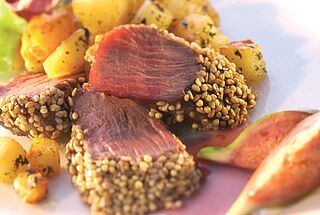Osterlaemmchen
Kendte vinmarker
German Wine for the Holidays: Osterlämmchen...Easter Lamb
Easter, the goddess of dawn
The lamb has long been an important symbol in the Jewish, Eastern Orthodox and Western Christian faiths. The lamb sacrificed on the first Passover commemorates the deliverance/exodus of the ancient Hebrews from slavery
in Egypt and the salvation of their children when God killed the first-born child in every Egyptian home but “passed over” the homes of the Israelites who had marked their doorsteps with lamb’s blood. Some biblical historians regard it as a foreshadowing of another act of salvation, when Christ, the “lamb of God,” shed his blood to deliver/redeem mankind from sin. Regardless of faith, the Paschal Lamb – from Pasch, meaning Passover or Easter – is deeply rooted in tradition, as is wine culture.
How, then, did a Mosel vineyard site, located midway between Cochem and Zell in the village of Ediger, acquire the name Osterlämmchen...literally, Easter lamb? The precise origins are not really known, but the name was documented in 1736 as “der Weingarten des Lämbtgen” and in 1761 in the Trier bishopric’s archive registry as “Weingarten am Osterlämbgen.” The name appears again in several documents from ca. 1900. Perhaps the vineyard name derives from the site’s proximity to Ediger’s St. Martin Church (see tourist tips below). Among church’s 117 bosses (carved projections capping the union of ribbed vaults), one depicts the “lamb of God.”
Osterlämmchen is a sloping to very steep site that consists of stony slate and weathered graywacke soils. It has a southeast to southwest exposure. Up until 1965, the site consisted of 35 ha/86 acres. It considerably dwindled in size during the three decades thereafter. About 15 ha/37 acres of the original site are still productive.
During “Flurbereinigung” (vineyard consolidation measures) in the 1990s, the Hasensprung site, a choice parcel located within the heart of Osterlämmchen, was incorporated into Osterlämmchen. Hasensprung, or hare’s leap, probably takes its names from the many rabbits in the area – they have always enjoyed munching on grapevines’ tender shoots.
Today’s Osterlämmchen is approximately 20 ha/50 acres, of which ca. 5-8 ha/12-20 acres are planted with red vines (Spätburgunder, Dornfelder); the majority of plantings are Riesling. It is interesting to note that these vineyards were very highly rated when Napoleon had properties appraised for tax purposes in the early 19th century. In 1897, the then-ruling Prussians published vineyard maps that were based on the assessments – a vineyard classification, so to speak – made by the French nearly a century earlier.
Alas, you are not likely to find Osterlämmchen wines in export markets...all the more reason to visit in person. A mature (three-to-five-year-old) Riesling of Spätlese ripeness would be a great accompaniment to a holiday meal featuring Easter lamb.
Tips for Tourists
Ediger is picturesque wine village full of 16th-18th-century half-timbered houses nestled within the remnants of the 14th-century town wall. St. Martin’s Church (11th–16th centuries) is celebrating its 500-year-anniversary in 2006 (the old church was “modernized” in Gothic style in 1506). This architectural gem boasts a Romanesque belfry (6 bells), a Gothic spire, magnificent star vaulting with 117 bosses, a baroque high altar, and an 18th-century Stumm organ. On display is a stone relief of “Christ in the Wine Press” (16th-century), which was originally housed in the Kreuzkapelle (Chapel of the Cross) on the Ediger Berg just outside of town. Ediger is ca. 7 km/4 miles from Cochem and 27 km/17 miles from Frankfurt-Hahn airport.
Many thanks for information from Kurt and Manuela Saffenreuther of Hotel/Restaurant Zum Löwen in Ediger. Their hotel and restaurant overlooking the Mosel offers reasonably priced rooms and delicious local cuisine, with homemade jams at breakfast and their estate-bottled Osterlämmchen wines with lunch or dinner. www.mosel-hotel.loewen.de. They contacted local historian Wolfgang Wolpert, who supplied additional details.
Thanks, too, to Michael Borchert of Springiersbacher Hof, who kindly supplied the photos. He and his brother Peter Göbel cultivate 3.5 ha/ca. 9 acres of vines in and near Ediger. Their historic wine cellar is a perfect setting for sampling Osterlämmchen wines. The property is one of several formerly owned by the Augustinian monastery Springiersbach. The family purchased it in 1806, in the aftermath of secularization. Today, the historical estate includes seven fully-equipped, reasonably priced holiday apartments.
www.ediger-mosel.de/weinberg.htm

